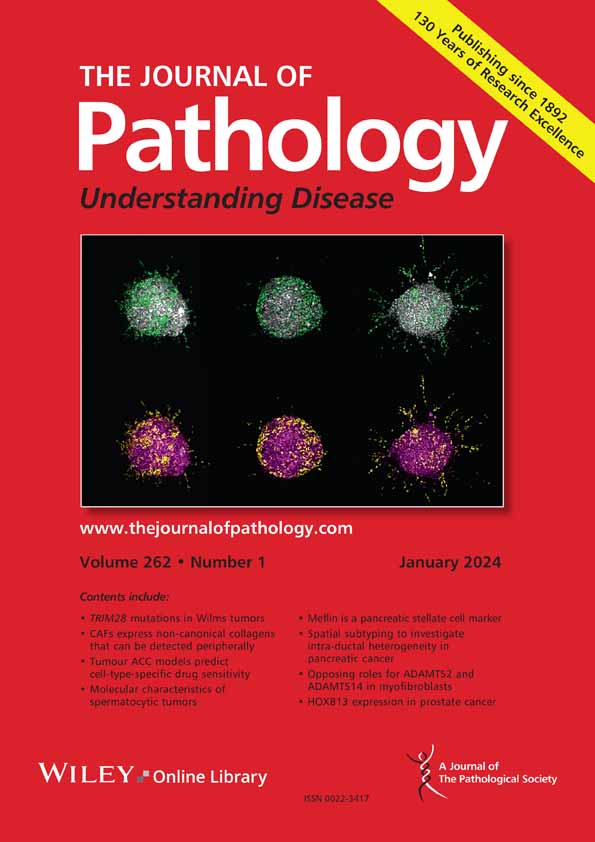Mengjie Yu, Dou Yang, Danxia Zhu, Yue Wang, Minmin Cao, Jingfeng Zhu, Wei Zhu, Guangji Wang, Jiye Aa
求助PDF
{"title":"循环代谢组学揭示了鸟苷单磷酸合成酶(GMPS)是肺腺癌的一个新的治疗靶点。","authors":"Mengjie Yu, Dou Yang, Danxia Zhu, Yue Wang, Minmin Cao, Jingfeng Zhu, Wei Zhu, Guangji Wang, Jiye Aa","doi":"10.1002/path.6442","DOIUrl":null,"url":null,"abstract":"<p>Metabolic reprogramming is pivotal in the initiation and progression of lung adenocarcinoma (LUAD). However, a substantial gap remains in the understanding of the primary drivers of metabolic reprogramming and alterations in early-stage LUAD. Using an unbiased, large-scale metabolomics analysis of 2,531 plasma and serum samples from three independent clinical centers, we identified significant perturbations in purine metabolism that characterized reprogrammed metabolism in early-stage LUAD. Additionally, hypoxanthine (<i>p</i> < 0.001) and xanthine (<i>p</i> < 0.05) were identified as two typical early risk indicators, with odd ratios (ORs) more than 2.8 and 1.45, respectively. Guanosine monophosphate synthetase (GMPS) was identified as a pivotal factor in the early development and malignant progression of LUAD. Progression of LUAD was significantly attenuated by <i>GMPS</i> knockdown and markedly exacerbated by its overexpression. Further data indicated that GMPS primarily contributed to the reprogrammed metabolic phenotypes of LUAD through its enzymatic activity and subsequent production of purine nucleotides, based on the relative abundance of the labeled isotope metabolites. Collectively, dysregulated purine metabolism emerged as a key characteristic of early-stage LUAD, and targeting GMPS activity may offer a promising therapeutic potential for LUAD treatment. © 2025 The Pathological Society of Great Britain and Ireland.</p>","PeriodicalId":232,"journal":{"name":"The Journal of Pathology","volume":"266 4-5","pages":"465-480"},"PeriodicalIF":5.2000,"publicationDate":"2025-06-20","publicationTypes":"Journal Article","fieldsOfStudy":null,"isOpenAccess":false,"openAccessPdf":"","citationCount":"0","resultStr":"{\"title\":\"Circulating metabolomics reveals guanosine monophosphate synthetase (GMPS) as a novel therapeutic target in lung adenocarcinoma\",\"authors\":\"Mengjie Yu, Dou Yang, Danxia Zhu, Yue Wang, Minmin Cao, Jingfeng Zhu, Wei Zhu, Guangji Wang, Jiye Aa\",\"doi\":\"10.1002/path.6442\",\"DOIUrl\":null,\"url\":null,\"abstract\":\"<p>Metabolic reprogramming is pivotal in the initiation and progression of lung adenocarcinoma (LUAD). However, a substantial gap remains in the understanding of the primary drivers of metabolic reprogramming and alterations in early-stage LUAD. Using an unbiased, large-scale metabolomics analysis of 2,531 plasma and serum samples from three independent clinical centers, we identified significant perturbations in purine metabolism that characterized reprogrammed metabolism in early-stage LUAD. Additionally, hypoxanthine (<i>p</i> < 0.001) and xanthine (<i>p</i> < 0.05) were identified as two typical early risk indicators, with odd ratios (ORs) more than 2.8 and 1.45, respectively. Guanosine monophosphate synthetase (GMPS) was identified as a pivotal factor in the early development and malignant progression of LUAD. Progression of LUAD was significantly attenuated by <i>GMPS</i> knockdown and markedly exacerbated by its overexpression. Further data indicated that GMPS primarily contributed to the reprogrammed metabolic phenotypes of LUAD through its enzymatic activity and subsequent production of purine nucleotides, based on the relative abundance of the labeled isotope metabolites. Collectively, dysregulated purine metabolism emerged as a key characteristic of early-stage LUAD, and targeting GMPS activity may offer a promising therapeutic potential for LUAD treatment. © 2025 The Pathological Society of Great Britain and Ireland.</p>\",\"PeriodicalId\":232,\"journal\":{\"name\":\"The Journal of Pathology\",\"volume\":\"266 4-5\",\"pages\":\"465-480\"},\"PeriodicalIF\":5.2000,\"publicationDate\":\"2025-06-20\",\"publicationTypes\":\"Journal Article\",\"fieldsOfStudy\":null,\"isOpenAccess\":false,\"openAccessPdf\":\"\",\"citationCount\":\"0\",\"resultStr\":null,\"platform\":\"Semanticscholar\",\"paperid\":null,\"PeriodicalName\":\"The Journal of Pathology\",\"FirstCategoryId\":\"3\",\"ListUrlMain\":\"https://pathsocjournals.onlinelibrary.wiley.com/doi/10.1002/path.6442\",\"RegionNum\":2,\"RegionCategory\":\"医学\",\"ArticlePicture\":[],\"TitleCN\":null,\"AbstractTextCN\":null,\"PMCID\":null,\"EPubDate\":\"\",\"PubModel\":\"\",\"JCR\":\"Q1\",\"JCRName\":\"ONCOLOGY\",\"Score\":null,\"Total\":0}","platform":"Semanticscholar","paperid":null,"PeriodicalName":"The Journal of Pathology","FirstCategoryId":"3","ListUrlMain":"https://pathsocjournals.onlinelibrary.wiley.com/doi/10.1002/path.6442","RegionNum":2,"RegionCategory":"医学","ArticlePicture":[],"TitleCN":null,"AbstractTextCN":null,"PMCID":null,"EPubDate":"","PubModel":"","JCR":"Q1","JCRName":"ONCOLOGY","Score":null,"Total":0}
引用次数: 0
引用
批量引用



 求助内容:
求助内容: 应助结果提醒方式:
应助结果提醒方式:


